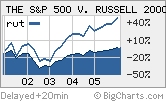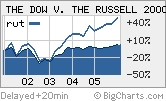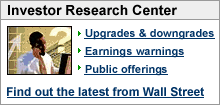|
Looking for the big cap rally
Despite encouraging signs, the market's big fish haven't managed a meaningful run in 2006. What gives?
NEW YORK (CNNMoney.com) - The Dow industrials are near 4-1/2 year highs -- both good and bad news for those betting that the long-lagging big-cap stocks are due for a comeback. The big-caps -- stocks with a market value of $5 billion or more -- have lagged their small- and mid-cap brethren for five years, most notably during the more than 3-year-old bull market, and some market analysts have been calling for that to change this year. (See chart).
Near the end of last year, a widely watched benchmark for smaller stocks, the Russell 2000 (Charts) index, was at an all-time high. But the Dow Jones industrial average (Charts) -- the barometer of 30 big blue chips and the world's most widely followed market average -- was back where it had been 4-1/2 years ago. As analysts looked ahead to 2006, many were betting that the economy would slow and that big-cap stocks would take on leadership roles in the market, while small- and mid-cap stocks might slow down. So far, no dice. "At the end of the fourth quarter, there were signs of large cap outperforming, but then it reversed early in 2006," said Grace Fey, a large-cap growth fund manager at Frontier Capital Management. That's partly because small caps tend to be strong in the first part of the year. But it's also due to the resilience of energy stocks this year, which keep thriving even as oil and gas prices have retreated. A big portion of energy stocks are mid-caps, with fewer small- or large-caps in the sector. The Amex Oil (Charts) index hit an all-time high in late January and so did the Russell 2000. Since then both have declined modestly, but many market analysts say they'll resume their advance. Beyond energy, large caps have been stuck in a range in recent years due to slower earnings growth and questions about valuation, said Fey, while the smaller names have generally seen faster earnings growth, which in turn has boosted their stocks. With the big stocks still stuck early this year, they've now lagged for so long that momentum players and others are skeptical of them. Ram Kolluri, chief investment officer at Global Value Investors, said he thought small and mid caps were more likely to provide a "sweet spot" for investors this year than large caps. But not everyone's counting the big stocks out for 2006. "There's this almost universal sense that we're in this big cap-ex spending cycle and the big stocks should be moving on that, but they haven't been," said Ken Tower, chief market strategist at CyberTrader, referring to a boost in corporate capital spending that's expected this year. That's one reason that the large caps may still be contenders this year. Earnings and valuations
Fey said her current portfolio has the best earnings potential in a long time and the best valuation in 15 years. She said her portfolio points to estimated earnings growth of 19 percent in 2006. The S&P 500 is currently expected to grow earnings by 12 percent in 2006 versus a year ago. Of her holdings, she especially likes Cisco and Texas Instruments in the tech sector, healthcare issues such as UnitedHealth and Novartis, the brokerage and investment bank firm Morgan Stanley and Nike, among retailers. Ben Halliburton, chief investment officer at Tradition Capital Management, also finds some big-cap stocks attractive. He said his firm has bought 3M, Coca-Cola and Wal-Mart over the last three months, names that were in favor in the late 1990s and haven't been since. But the apparently attractive prices for those stocks relative to earnings perhaps should be taken with a grain of salt, said Manny Weintraub, managing director at Integre Advisors. He said that on one hand, companies such as Intel and General Electric look like they offer a good value relative to 2006 earnings forecasts. Both companies have P/E ratios that trade around 17 times 2006 earnings, while the Russell 2000 trades at 22.6 times 2006 earnings. Yet, the low valuations are based on earnings estimates that he says are risky. "Companies like Tyco, Microsoft and Intel are giving full-year estimates that require the second half to be better than the first half," Weintraub said. "And that's not so much because of expectations about when the economy turns, but reasons related to product launches and other developments." He said he thinks the mid-cap space may offer better values, especially since the sector is more likely to have companies that could be targets for takeovers, especially by private investor groups -- a trend that's has been heating up for some time. Even if the small- and mid-cap groups continue to perform well, large U.S. companies could still benefit in 2006 from any waning interest in international stocks and funds, which have surged in the last few years and may be losing some of their luster, said Tradition Capital's Halliburton. "We're seeing fewer opportunities in the international space than we have over the last few years," Halliburton said. "I think the opportunities this year are definitely more so in U.S. stocks." ------------------------- Is the January effect still effective? Full story.
For the latest market news, click here. |
|




